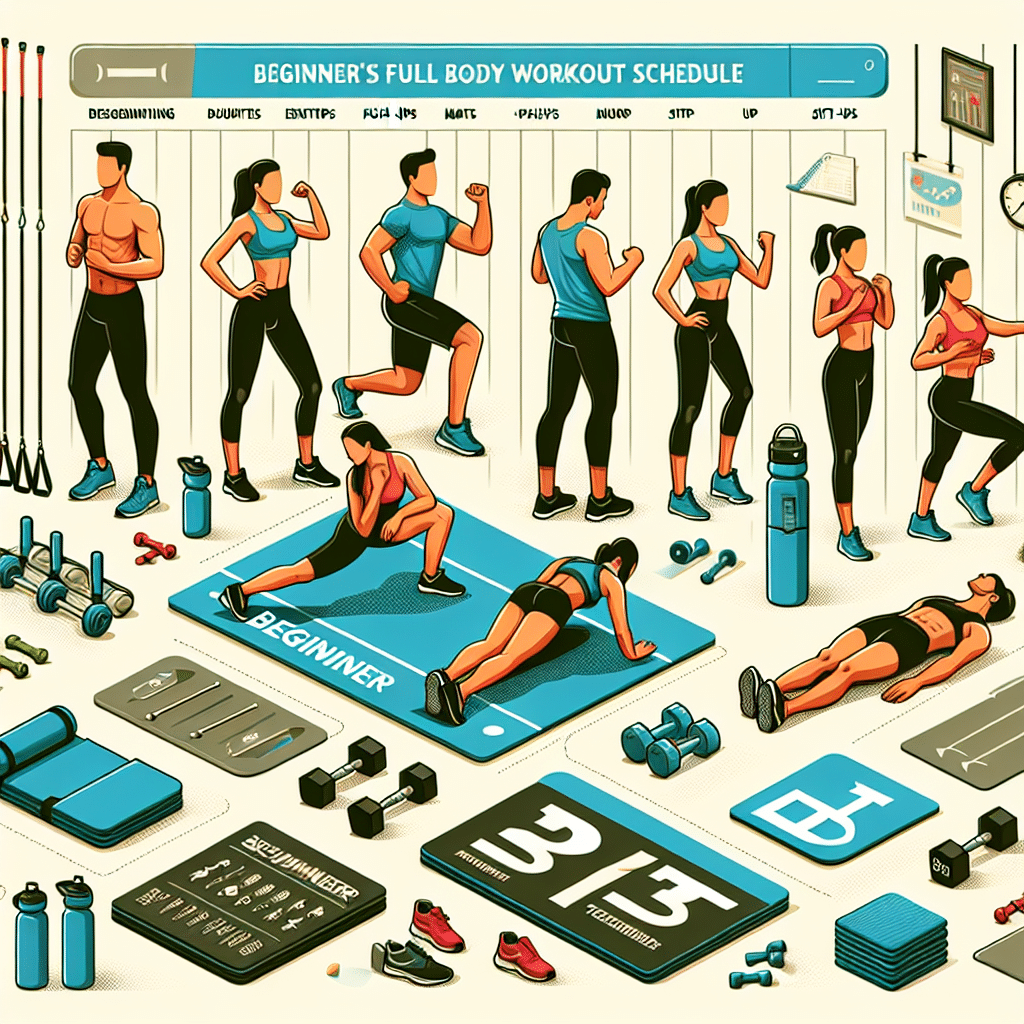Understanding Full-Body Workouts
A full-body workout targets multiple muscle groups in a single session, making it an efficient choice for beginners aiming to develop strength, endurance, and overall fitness. Coordinating a well-structured workout plan not only enhances muscle growth but also improves cardiovascular health and raises metabolism.
Benefits of Full-Body Workouts
- Efficiency: In a time-crunched world, full-body workouts allow you to engage all major muscle groups in fewer training sessions.
- Balanced Strength: Ensuring all muscle groups work equally helps prevent imbalances and reduces the risk of injury.
- Increased Metabolism: Combining strength exercises with high-intensity movements can elevate your metabolic rate.
- Flexibility: You can easily adjust your schedule, dedicating fewer days to training without sacrificing results.
Setting Goals
Begin by defining clear, achievable goals:
- Weight loss: Aim for a calorie deficit.
- Muscle gain: Focus on progressive overload.
- Endurance: Incorporate higher-repetition, lower-weight exercises.
Determining Workout Frequency
For beginners, a frequency of 3 days per week is recommended. This allows sufficient recovery while providing enough stimulation for muscle growth. A sample schedule might look like:
- Monday: Full-body workout
- Wednesday: Full-body workout
- Friday: Full-body workout
Creating Your Workout Schedule
1. Warm-Up (5-10 minutes)
A proper warm-up prepares your body for exercise by increasing blood flow to muscles and enhancing joint mobility. Consider dynamic stretches and light aerobic activities, such as:
- Arm circles
- Leg swings
- Jumping jacks
- Bodyweight squats
2. Exercise Selection
Choose a mix of compound and isolation exercises. Compound movements engage multiple joints and muscle groups, while isolation exercises focus on singular muscles.
Example Weekly Full-Body Workout Routine:
Day 1 (Focus on Strength):
- Squats (3 sets of 8-12 reps)
- Push-Ups (3 sets of 8-10 reps)
- Bent-Over Rows with Dumbbells (3 sets of 8-12 reps)
- Dumbbell Shoulder Press (3 sets of 8-12 reps)
- Plank (3 sets for 30-45 seconds)
Day 2 (Focus on Endurance):
- Lunges (3 sets of 10-15 reps per leg)
- Incline Push-Ups (3 sets of 8-12 reps)
- Deadlifts using Dumbbells (3 sets of 10-15 reps)
- Wall Sits (3 sets for 30-45 seconds)
- Russian Twists (3 sets of 15-20 reps)
Day 3 (Combination & HIIT):
- Burpees (3 sets of 8-12 reps)
- Goblet Squats (3 sets of 8-12 reps)
- Pull-Ups or Assisted Pull-Ups (3 sets of 5-8 reps)
- Kettlebell Swings (3 sets of 15-20 reps)
- Mountain Climbers (3 sets for 30 seconds)
3. Cool Down (5-10 minutes)
Cooling down aids your heart rate and optimizes recovery. Incorporate static stretches focusing on the major muscle groups.
Cool Down Routine:
- Hamstring stretch
- Quad stretch
- Chest opener
- Shoulder stretch
Progression
As you grow stronger, consider adjustments to your routine:
- Increase weights gradually by 5%-10% when exercises become easy.
- Add more sets or reps for additional intensity.
- Shorten rest time to challenge your conditioning.
Tracking Progress
Keep a workout journal or use fitness apps to document:
- Repetitions performed
- Weights lifted
- Workouts completed
- Note how you feel post-workout
Nutrition for Beginners
Proper nutrition plays a crucial role in fitness progression. To optimize results:
- Protein: Include lean meats, dairy, and legumes to support muscle repair and growth.
- Carbohydrates: Consume complex carbs for energy—oats, sweet potatoes, and whole grains are excellent sources.
- Healthy Fats: Incorporate avocados, nuts, and olive oils for overall health.
- Hydration: Drink plenty of water before, during, and after training.
Listening to Your Body
Learning to interpret your body’s signals will help you avoid injury and fatigue. Acknowledge:
- Fatigue: More than typical soreness may indicate the need for a rest day.
- Pain: Distinguish between muscle soreness and sharp pain—seek help if pain persists.
Equipment Needed
While many bodyweight exercises require no equipment, additional tools can enhance your routine. Consider:
- Dumbbells: Versatile for adding resistance.
- Kettlebells: Great for dynamic movements.
- Resistance Bands: Ideal for beginners, providing variable resistance.
Scheduling Rest Days
Rest is essential for muscle recovery and growth. Schedule rest days strategically; allow 48 hours of recovery between workouts focusing on the same muscle groups.
Adapting the Plan
Every individual’s fitness journey is unique. Adjust the workout plan based on your fitness levels, equipment availability, and personal goals.
Incorporating Cardiovascular Training
Include light cardio exercises on non-workout days or after your lifting sessions. Options like jogging, cycling, or swimming increase aerobic capacity and enhance overall conditioning.
Ensuring Consistency
Establish a routine that fits seamlessly into your lifestyle. Consistency is key—make a commitment by setting reminders or pairing workouts with enjoyable activities, like group classes or workout sessions with friends.
Beginner Workouts Online
Exploit abundant resources available online for routine guidance:
- YouTube: Fitness channels provide visual instructions and tips.
- Workout Apps: Track progress and find new exercises.
- Online Communities: Engage with other fitness enthusiasts for motivation.
By following these structured guidelines, you can effectively embark on your fitness journey lay the foundation for a functional, healthy lifestyle through a balanced full-body workout schedule tailored to meet beginner needs.
